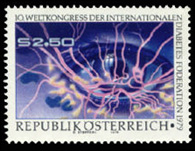


11.1 Pre-proliferative retinopathy
By definition, this stage precedes overt neovascularization, and is characterized
by venous beading and dilatation, large blot retinal haemorrhages, cotton-wool
spots (in the absence of systemic hypertension), intra-microvascular abnormalities,
and areas of capillary underperfusion as shown by fluorescein angiography61.
However, the definition of pre-proliferative retinopathy is difficult since not all
patients who develop proliferative retinopathy pass through the preproliferative
phase, and many do not show all the features described above. Accordingly, we
recommend the concepts of ‘high risk’ and ‘low risk’ retinopathy (see section 2 on
clinical classification).
.
It is, however, an important stage to recognize since 10 to 50 % of patients with
‘high risk’ (pre-proliferative) retinopathy will develop overt proliferative changes
within 1 year62. Such patients require at least 4 monthly follow up to allow the
earliest detection of proliferative changes. On theoretical grounds, all patients
should go through the preproliferative stage. That this is not the case may well
be due to the relatively transient nature of the some of the lesions. In addition,
pre-proliferative retinopathy in the presence of a posterior vitreous detachment
cannot a priori progress to proliferative retinopathy although rubeosis iridis can
still occur (see below). Cotton wool spots have a time course of 6-12 months,
and blotch haemorrhages as well as IRMA’s disappear once extensive capillary
closure has developed.
.
Opinions differ on whether to treat pre-proliferative retinopathy. Most studies
have failed to show any benefit, provided that adequate follow up is achieved63.
In mild forms where less than two of the features of the condition are present,
and particularly where there are only a few cotton wool spots, progression is not
certain and indeed spontaneous regression may occur64. In the United States
the preferred practice in cases of bilateral pre-proliferative retinopathy is to
treat one eye with pan-retinal photocoagulation and observe the second eye
at three monthly intervals.
.
11.2 Rubeosis iridis
This is a manifestation of severe retinal ischaemia and heralds the onset of
rubeotic glaucoma. In the presence of clear media, further immediate
photocoagulation should be applied since regression can be induced although
this is perhaps better documented following central retinal occlusion65. However
rubeosis is often associated with advanced PDR rendering it impossible to apply
further laser due to vitreous haemorrhage. In these circumstances prompt
vitreous surgery is required to enable preoperative photocoagulation to be carried
out (see above). The results of the Early Vitrectomy Study show the benefits of
surgery in eyes with severe neovascularization and vitreous haemorrhage54; the
presence of rubeosis indicates that surgery cannot be further delayed. Ultrasound
examination is mandatory to exclude retinal detachment, since co-existing rubeosis
implies a poorer prognosis for surgery (see above).
.
Glaucoma due to rubeosis responds poorly to standard trabeculectomy procedures66.
When trabeculectomy is combined with mitomycin-C however, the results are more
encouraging67, and compares favourably with other anti-proliferative agents such as
5-Fluorouracil68 as well as other surgical procedures such as drainage tubes and cyclo-
cryotherapy. When it is possible to apply further photocoagulation, trabeculectomy
with mitomycin should be delayed for 1-4 weeks to allow as much regression of the
rubeosis as possible prior to surgery66. In eyes which are already blinded by rubeotic
glaucoma, topical steroids together with atropine is the appropriate palliative
treatment.
.
11.3 Systemic hypertension
In both IDDM and NIDDM patients systemic hypertension is commoner than in non-
diabetics69,70 (see risk factors above). Since it is well recognized that systemic
hypertension hastens the development of background and proliferative
retinopathy4,5,20,71, it is important that ophthalmologists identify signs of coexisting
hypertensive retinopathy. Some of the features of accelerated hypertensive
retinopathy such as retinal haemorrhages, cotton wool spots and capillary closure
are similar to diabetic changes, but there are often subtle differences with, in
particular, flame shaped retinal haemorrhages being characteristic of hypertension.
The thickening of the arterial wall of the retinal vessels together with A-V nipping
are also consistent features of systemic hypertension.
.
Whilst the association between hypertension and diabetic retinopathy is established,
there are few studies regarding the effects of treatment of hypertension on diabetic
retinopathy. In one reported study, it has been shown that treating hypertension
minded result in improvement of retinopathy72. Since both diabetic retinopathy and
nephropathy are the result of microangiopathy, it should be the concern of those
treating patients with retinopathy to attend to concomitant hypertension. ACE
inhibitors appear to control hypertension well in these circumstances and may
therefore be the drugs of choice.
.
At the present time, it is reasonable to expect ophthalmologists to recognize the
effects of hypertension on diabetic retinopathy and if not already diagnosed, to
draw it to the attention of the physicians. It should be realized however, that
prevention of the visual damage associated with retinopathy can only be achieved
in the early stages. Treatment of established maculopathy or PDR is not
accompanied with visual improvement, only with halting the disease process.
.
11.4 Retinal vein occlusion
Diabetes is recognized as a predisposing factor in the causation of retinal venous
occlusion73. Many cases of branch or central vein occlusion occur in diabetics
without retinopathy in which the management is the same as in non-diabetics
ie pan-retinal laser photocoagulation if significant areas of capillary non-perfusion
have been identified by fluorescein angiography, in order to prevent retinal
neovascularization or rubeosis iridis74. Although the natural history of branch
retinal vein occlusion is probably little different in diabetics without retinopathy,
there is a significant higher rate of neovascular glaucoma75 and such patients
require evaluation of the extent of retinal ischaemia by fluorescein angiography
to enable timely photocoagulation to be applied.
.
Retinal venous occlusion occurring in patient with established diabetic retinopathy
may prove more difficult to assess and treat. Where there are already extensive
haemorrhages and exudates from diabetic retinopathy, the subsequent development
of a venous occlusion can be missed and must be considered where ‘asymmetric
retinopathy’ has developed